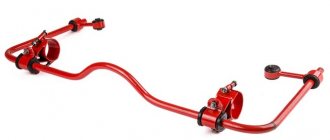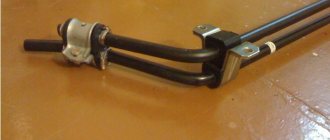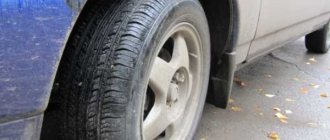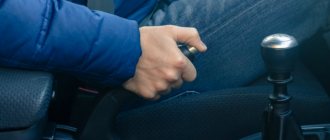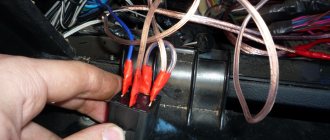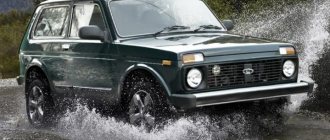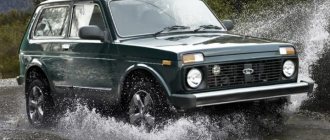What to do in case of skidding?
The most common cases are when the rear axle of a front-wheel drive car develops skidding. Here the front of the car continues to move in the same direction. At the same time, the rear wheels stop following. Thus, rotational movements occur, which intensify under the influence of centrifugal force.
You can correct the situation if you determine the reason for its development:
- sliding caused by too sharp a start, acceleration requires a reduction in speed - you need to stop pressing the gas;
- In situations caused by sudden braking, you need to stop pressing the brake.
These actions are aimed at reducing the dangerous effects of lateral forces.
To optimize the situation it is important:
- turn the steering wheel in the direction where the car is skidding; then the car will begin to turn in the opposite direction and will take its original position;
- you need to control the steering wheel evenly, ensuring a gradual return of the wheels to the desired position;
- To prevent a rear-wheel drive vehicle from skidding in the other direction, it is recommended to turn the steering wheel so that the angle is proportional to the amount of the current slip.
During operation, movements should be smooth so that the situation does not worsen to the point of developing a serious or rhythmic skid.
Briefly about the causes of traffic disorders
There are a number of possible reasons:
- The wheels lose traction when braking hard. Such an incident is possible even on a dry road. In rain or snow, stopping traffic is prohibited.
- Tire pressure that is too low reduces traction. Check the indicator regularly and inflate the tires in a timely manner.
- Traffic may be disrupted in the event of a sudden change in road surface (for example, from asphalt to gravel). High speed increases the risk of an accident.
- It is dangerous to corner the road at high speeds. In this case, the vehicle most often flies into a ditch or into the oncoming lane. On slopes and mountain roads, special care should be taken.
- Drifting is a special type of controlled drift that race car drivers use to navigate corners on a race track.
- Ruts and unevenness are dangerous. If they are present, it is more difficult for drivers to control vehicles. It is possible to lose control on slopes and descents.
- Adverse weather conditions may have an impact. Cars are more likely to skid when it rains or ice forms on the highway.
Skidding of rear-wheel drive cars
It is not difficult to understand the reasons for the development of the situation. The problem is to learn how to get out of it, overcoming the fear that sometimes appears in the initial stages. The most difficult thing is to skid the rear axle of a rear-wheel drive car.
You can’t miss the moment here, you need to act immediately:
- When a skid develops, the rear of the car is pulled to the side, and the steering wheel turns in the same direction.
- Depending on the reason for the formation of such a situation, either the gas pedal or the brake is released.
- Next, you need to work the steering wheel until the rear of the car returns to its original position.
- At this point, the steering wheel should return to the position required for subsequent movement.
It is extremely undesirable, and even dangerous, during this period:
- use the handbrake;
- try to change gear;
- press on the brake.
All this leads to increased skidding and the development of a serious emergency situation.
Four-wheel drive
A four-wheel drive vehicle is the most stable on ice. It will cling to the surface with all its wheels until the last moment, but... |
...an all-wheel drive vehicle skidding occurs abruptly, and you need to be prepared for this. |
Skidding of front-wheel drive cars
When a front-wheel drive car skids when turning, it is worth considering the design feature.
Here the front wheels should pull the car, so you need to press on the gas, promoting an increase in speed. In this case, the driver must ensure that the front wheels do not spin.
Steps requiring attention:
- Without stopping to press on the gas, it is necessary to align the wheels in the front.
- Timely action when a car skids is extremely important. Therefore, a moment before the stern is returned to its original position, the rudder turns in the opposite direction.
- The steering wheel returns to its original position before the rear end stabilizes.
When the danger has passed, the speed decreases and normal movement continues.
Correct fit
Good driving instructors often draw the attention of their students to the correct seating position. It is very important for comfortable driving. And the point here is not even about convenience, the point here is how sensitively you can track the behavior of your car on the road and react in time to its changes. When driving, do not go to extremes.
You shouldn’t sit clutching the steering wheel, since such excessive tension will lead to rapid fatigue and dissipation of attention, but you shouldn’t fall into a reclining position, imposingly turning the steering wheel with one finger.
A complete lack of concentration on the road situation is unacceptable. When driving, visibility is of great importance, and, in addition to it, the ability to reach any buttons and control levers at any time. A skid is usually the result of human error. The more severe the error, the greater the skidding angle you will get as a result. Of course, it will be easier for a driver who has extensive driving experience to cope with a skid. However, there is a way out for beginners too. You can take an additional lesson to improve your skills. Such training under the guidance of an experienced instructor will significantly increase your confidence on the winter road and protect you from unpleasant incidents.
Subtleties of output for all-wheel drive vehicles
Operating all-wheel drive models requires skills and knowledge of what to do when the car skids, since these situations are the most dangerous. Often the driver can only wait until the car stops. The type of all-wheel drive matters here. Also, most of it can be fed to a specific axis.
To prevent loss of control of the car, you should follow the recommendations:
- If this does happen, you should turn the steering wheel directly in the direction the car is skidding. The later the reaction, the faster you need to turn the steering wheel to stabilize the vehicle.
- Proper seating and the absence of sudden maneuvers while driving help prevent unforeseen situations.
- It is important not to release the gas, and pressing the brake pedal will make it impossible to maneuver further, which will aggravate the situation.
A situation such as a car skidding on the road is quite dangerous. But even worse is to succumb to fear. This is where mental toughness, experience and preparation go a long way. You can improve your skills by artificially creating drifts on areas or sections of the roadway where there are no other cars or pedestrians.
Why does loss of control occur?
Loss of traction between tires and road surface does not just happen. There are always reasons for a car skidding, which are represented by mistakes, making wrong decisions while driving.
- Skidding when pressing the gas or braking is common. The solution is to stop pressing the gas or brake pedal and continue maneuvering.
- Loss of control when entering a turn occurs as a result of:
- sharp turn of the steering wheel;
- cornering at high speed;
- sharply pressing or releasing the gas pedal when performing a maneuver;
- a strong, sudden application of the brake.
In winter, when the road is slippery, any sudden maneuver or movement of the driver leads to loss of control.
The following road sections require special attention:
- turns in places with serious unevenness;
- steep descents;
- zones of forced movement on a slope.
Correct sitting, accompanied by a tight fit of your back to the seat, allows you to sense a loss of control in time and take measures to restore safety. This approach will allow you to learn how to identify drifts at the initial stage and quickly get out of them.
Where to learn dangerous maneuver?
Drivers who have mastered standard driving skills and have a good feel for the car should learn extreme driving techniques. Such training is conducted by extreme driving instructors on wide training grounds and training grounds specially designed for practicing extreme driving techniques. This eliminates the possibility of creating an emergency situation or the danger of injuring bystanders. On the road, the main thing when accelerating is to think not about speed, but about whether you can react with lightning speed and perform an emergency maneuver. The cost of such courses is difficult to guess; it depends on the specific city and the driving school that provides such services.
Controlled skidding is a useful skill worth mastering.
Why it is not recommended to skid
Slipping is an action that affects not only new car enthusiasts, but also experienced car owners. Everyone is familiar with the situation when you are in a hurry, flying at full speed to a meeting or home in the evening, you do not notice a snowdrift and drive into it.
Read
Diagnostics, repair and replacement of automatic transmission torque converter
This makes you angry and you start rocking the car, just like you do with a manual car. Does everyone know this feeling? So, under no circumstances should you do automatic swinging.
Slipping is fraught with overloads on the planetary gearbox and torque converter of the machine. The following happens when you try to check out:
- The oil in the bagel overheats over 100 degrees in the machine. It cannot act as a protector and lubricant when overheated.
- Due to the constant shifting of gears from “D” to “R”, clutches and steel discs with teeth rub against each other intensely.
- Overheating affects all automatic transmission systems.
- As a result, the car owner receives an overheated automatic machine with a shortened lifespan.
Attention! After prolonged slipping, it is necessary to immediately change the lubricant in order to somehow smooth out the car owner’s mistakes.
Basic recommendations
Some drivers are confident that after studying the theory of skidding and getting out of them, they know exactly how to act correctly, and this will not happen to them.
But practice shows that the driver is already dooming himself to loss of control just after he gets behind the wheel. There are basic rules that drivers forget about. It is their violation that does not allow you to apply all your theoretical skills.
- Landing. The driver must take the most comfortable position in the vehicle. It’s not for nothing that modern cars are equipped with special drives and levers that allow you to adjust the chair to your height, weight, arm length and a number of other parameters. This is a matter of not only comfort, but also safety. The more comfortable it is for the driver, the less he will be distracted by back pain or numb hands. Therefore, the main attention is paid to the situation on the road.
- Hand position. Everyone needs to get rid of this habit of pathetically driving the steering wheel with one hand at once. Yes, if you are stuck in a traffic jam and gradually move around, having an automatic transmission at your disposal, then steering with one hand is still allowed. But when you are moving at high speed, on a bad road, both hands must be on the steering wheel. Moreover, they should be positioned as conveniently and correctly as possible. To regain control in a skid, every moment counts. And if your hands are positioned incorrectly, you simply will not be able to turn at the right moment and to the required degree.
- Concentration. When the road is slippery and visibility is poor, you should never be distracted from managing and monitoring the traffic situation. Try to concentrate. Then you will significantly reduce the likelihood of losing control.
Start with these basic tips. If you adhere to them, then the likelihood of entering an uncontrolled skid will be significantly reduced.
Steering wheel, gas and clutch
It happens that the car driving in front of you passed the turn easily, but the wheels of your car, which entered the same turn, suddenly began to slip. What's the matter? In fact, the driver of the car driving in front of you is an experienced driver. Before entering the turn, he turned the steering wheel to a larger angle than necessary and released the gas, switching to a lower gear. Thus, the front of the car seemed to be buried in the ground, the wheels received the greatest contact with the road surface, and no skidding occurred.
Experienced drivers demonstrate aerobatics by synchronously controlling the car when skidding using the steering wheel, gas pedal and, oddly enough, the clutch.
For example, if the car starts to rotate, then briefly pressing the clutch pedal will help stop this rotation. When driving in deep snow, the engine begins to lose speed, but if you temporarily disengage the clutch, the speed is restored. If you urgently need to brake on a slippery surface, the clutch will help you shift to lower gears until the car comes to a complete stop.
How to avoid being blinded by the headlights of an oncoming car on a night road
How to protect yourself on the roads in winter
Subscribe to our channel in Yandex.Zen or Yandex.Chat
Add Pravda.Ru to your sources in Yandex.News or News.Google
When you need to be alert
Here it is worth accepting the fact that in the vast majority of cases, skidding occurs due to the fault of the driver himself. It is very rare that a tire suddenly bursts and the driver loses control of the vehicle.
There are some basic guidelines for when to be prepared:
- poor visibility on the road;
- the road surface is covered with frost in the morning;
- there is slight icing on the road;
- the road is covered with snow;
- In winter, the snow gradually melts, which is why it turns into snow porridge;
- you know about the severe wear of the tread;
- there are problems with the brake system;
- the correct operation of the steering wheel is impaired;
- The seasonal tires on the car have not been replaced.
If the car is in a condition that does not allow you to confidently move at high speed and pass all emerging obstacles, slow down the engine speed and take your time.
It happens that the driver did not have time to switch to winter tires because it was warm, and suddenly snow fell. You have to go to the service station on summer tires. And this is extremely dangerous. The same goes for worn tread, faulty brakes and steering. In such situations, it is better to seek help from evacuation services. They will load the car onto a platform and deliver it to a car service center for subsequent repairs.
But a fully serviceable car with new tires does not always protect against skidding. Here we are talking purely about the mistakes of the driver himself, who does not take into account the road situation, relies too much on electronics and forgets that driving on ice, wet leaves or puddles at high speed, or driving into them with one side of the car, is potentially very dangerous.
Skid protection starts with learning proper driving behavior. The better you control the situation, follow traffic rules and take into account the condition of the road, the less likely you are to encounter the need to get out of a skid.

